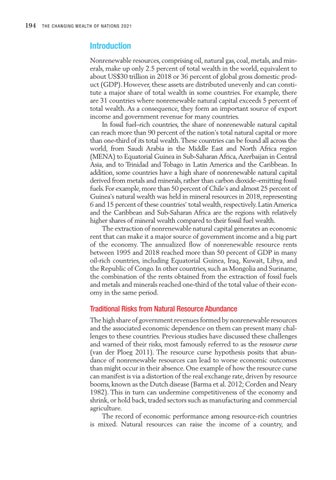194
T H E C H A N G I N G W E A LTH O F N ATIO N S 2021
Introduction Nonrenewable resources, comprising oil, natural gas, coal, metals, and minerals, make up only 2.5 percent of total wealth in the world, equivalent to about US$30 trillion in 2018 or 36 percent of global gross domestic product (GDP). However, these assets are distributed unevenly and can constitute a major share of total wealth in some countries. For example, there are 31 countries where nonrenewable natural capital exceeds 5 percent of total wealth. As a consequence, they form an important source of export income and government revenue for many countries. In fossil fuel–rich countries, the share of nonrenewable natural capital can reach more than 90 percent of the nation’s total natural capital or more than one-third of its total wealth. These countries can be found all across the world, from Saudi Arabia in the Middle East and North Africa region (MENA) to Equatorial Guinea in Sub-Saharan Africa, Azerbaijan in Central Asia, and to Trinidad and Tobago in Latin America and the Caribbean. In addition, some countries have a high share of nonrenewable natural capital derived from metals and minerals, rather than carbon dioxide–emitting fossil fuels. For example, more than 50 percent of Chile’s and almost 25 percent of Guinea’s natural wealth was held in mineral resources in 2018, representing 6 and 15 percent of these countries’ total wealth, respectively. Latin America and the Caribbean and Sub-Saharan Africa are the regions with relatively higher shares of mineral wealth compared to their fossil fuel wealth. The extraction of nonrenewable natural capital generates an economic rent that can make it a major source of government income and a big part of the economy. The annualized flow of nonrenewable resource rents between 1995 and 2018 reached more than 50 percent of GDP in many oil-rich countries, including Equatorial Guinea, Iraq, Kuwait, Libya, and the Republic of Congo. In other countries, such as Mongolia and Suriname, the combination of the rents obtained from the extraction of fossil fuels and metals and minerals reached one-third of the total value of their economy in the same period.
Traditional Risks from Natural Resource Abundance The high share of government revenues formed by nonrenewable resources and the associated economic dependence on them can present many challenges to these countries. Previous studies have discussed these challenges and warned of their risks, most famously referred to as the resource curse (van der Ploeg 2011). The resource curse hypothesis posits that abundance of nonrenewable resources can lead to worse economic outcomes than might occur in their absence. One example of how the resource curse can manifest is via a distortion of the real exchange rate, driven by resource booms, known as the Dutch disease (Barma et al. 2012; Corden and Neary 1982). This in turn can undermine competitiveness of the economy and shrink, or hold back, traded sectors such as manufacturing and commercial agriculture. The record of economic performance among resource-rich countries is mixed. Natural resources can raise the income of a country, and


